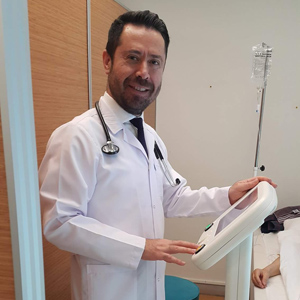
Regionally radiofrequency (RF) hyperthermia (modulated electrohyperthermia, Oncothermia)
Hyperthermia is a complementary treatment method developed for cancer. With the current hyperthermia devices developed by modern technology, heat is transferred to cancer cells located in superficial or deep tissues. Special radiofrequency (RF) waves developed to target cancer cells create a temperature of 42-44© degrees in this region. The heat created in this controlled manner helps to disrupt the metabolism of cancer cells and to prevent the production of proteins and enzymes necessary for them.
Cancer cells secrete proteins and enzymes as a reflex to protect themselves from the lethal effects of cancer treatments such as radiotherapy or chemotherapy. As a result, a portion of the cancer cells survives and continue to multiply, leading to the failure of cancer treatment and the danger to the patient's life.
Hyperthermia also helps to prevent the production of proteins and enzymes necessary for the survival of cancer cells (1). Therefore, it increases the lethal effect of radiotherapy, chemotherapy, immunotherapy, cancer vaccines, and targeted therapies on cancer cells. It also increases oxygenation and blood circulation in the cancer mass, improving the effectiveness of medical treatment (1-4).
The effectiveness of using hyperthermia in combination with chemotherapy and/or radiotherapy has been investigated in various clinical studies. These studies have focused on the treatment of cancers of the head and neck, brain, lung, esophagus, breast, bladder, rectum, liver, appendix, cervix, abdominal wall (peritoneum, mesothelioma), and tumors such as melanoma and sarcoma (1,2,4,8,11,12,13,14). Most studies have shown that the use of deep tissue RF regional hyperthermia in combination with cancer treatment significantly increases the chance of recovery (1,2,4,7,8).
It is also used as a supportive treatment for patients who cannot undergo certain medical treatments. A response rate of 13% was obtained in cancer cases treated with hyperthermia alone (2). RF hyperthermia, combined with high-dose vitamin C and phytotherapy, has been used as a supportive treatment for patients who cannot undergo certain medical treatments and has shown significant improvement in the response rate and survival rate (2).
Deep tissue RF hyperthermia (modulated electrohyperthermia, Oncothermia); it specifically increases the release of heat shock proteins (Hsp70 and Hsp90) in cancer cells through heat (15). The release of Hsp70 and Hsp90 proteins increases the activity of anticancer cytotoxic T lymphocytes and natural killer cells against cancer cells. It provides benefits by improving the anticancer immune system (16).
In a new phase 2 clinical study, the benefit of best supportive care (BSC) versus modulated electrohyperthermia (mEHT) and high-dose vitamin C administration in addition to BSC was investigated in patients with terminal stage metastatic non small cell lung cancer who did not respond to standard cancer treatment (17). A total of 97 patients were randomized to receive IVC and mEHT plus best supportive care (BSC) (n = 49 in the active arm, receiving 1 g/kg * d IVC concurrently with mEHT, three times a week for 25 treatments in total) or BSC alone (n = 48 in the control arm). After a median follow-up of 24 months, progression-free survival (PFS) and overall survival (OS) were significantly prolonged by combination therapy compared to BSC alone (PFS: 3 months vs 1.85 months, P < 0.05; OS: 9.4 months vs 5.6 months, P < 0.05). QoL was significantly increased in the active arm despite the advanced stage of disease. The 3-month disease control rate after treatment was 42.9% in the active arm and 16.7% in the control arm (P < 0.05). Overall, IVC and mEHT may have the ability to improve the prognosis of patients with advanced NSCLC.
In our clinic, regional deep tissue RF hyperthermia, modulated electrohyperthermia and Oncothermia treatments are performed with Oncotherm EHY – 2030 and Oncotherm EHY – 3010 devices, using electrodes suitable for the cancer regions of the patients, together with our experienced healthcare team.
Reference:
1. http://www.cancer.gov/about-cancer/treatment/types/surgery/hyperthermia-fact-sheet
2. van der Zee J. Heating the patient: a promising approach? Annals of Oncology 2002; 13(8):1173–1184. [PubMed Abstract]
3. Hildebrandt B, Wust P, Ahlers O, et al. The cellular and molecular basis of hyperthermia. Critical Reviews in Oncology/Hematology 2002; 43(1):33–56. [PubMed Abstract]
4. Wust P, Hildebrandt B, Sreenivasa G, et al. Hyperthermia in combined treatment of cancer. The Lancet Oncology 2002; 3(8):487–497. [PubMed Abstract]
5. Alexander HR. Isolation perfusion. In: DeVita VT Jr., Hellman S, Rosenberg SA, editors. Cancer: Principles and Practice of Oncology. Vol. 1 and 2. 6th ed. Philadelphia: Lippincott Williams and Wilkins, 2001.
6. Falk MH, Issels RD. Hyperthermia in oncology. International Journal of Hyperthermia 2001; 17(1):1–18. [PubMed Abstract]
7. Dewhirst MW, Gibbs FA Jr, Roemer RB, Samulski TV. Hyperthermia. In: Gunderson LL, Tepper JE, editors. Clinical Radiation Oncology. 1st ed. New York, NY: Churchill Livingstone, 2000.
8. Kapp DS, Hahn GM, Carlson RW. Principles of Hyperthermia. In: Bast RC Jr., Kufe DW, Pollock RE, et al., editors. Cancer Medicine e.5. 5th ed. Hamilton, Ontario: B.C. Decker Inc., 2000.
9. Feldman AL, Libutti SK, Pingpank JF, et al. Analysis of factors associated with outcome in patients with malignant peritoneal mesothelioma undergoing surgical debulking and intraperitoneal chemotherapy. Journal of Clinical Oncology 2003; 21(24):4560–4567. [PubMed Abstract]
10. Chang E, Alexander HR, Libutti SK, et al. Laparoscopic continuous hyperthermic peritoneal perfusion. Journal of the American College of Surgeons 2001; 193(2):225–229. [PubMed Abstract]
11. Snider JW 3rd, Datta NR, Vujaskovic Z. Hyperthermia and radiotherapy in bladder cancer. Int J Hyperthermia. 2016 Apr 20:1-9.
12. Linthorst M, Baaijens M, Wiggenraad R, Creutzberg C, Ghidey W, van Rhoon GC, van der Zee J. Local control rate after the combination of re-irradiation and hyperthermia for irresectable recurrent breast cancer: Results in 248 patients. Radiother Oncol. 2015 Nov;117(2):217-22.
13. Shen H, Li XD, Wu CP, Yin YM, Wang RS, Shu YQ. The regimen of gemcitabine and cisplatin combined with radio frequency hyperthermia for advanced non-small cell lung cancer: a phase II study. Int J Hyperthermia. 2011;27(1):27-32.
14. Yang M, Zhao J, Wang Y. BSD2000 deep hyperthermia combined with chemotherapy of PT regimen in patients with non-small cell lung cancer. Zhongguo Fei Ai Za Zhi. 2010 Feb;13(2):132-5.
15. Multhoff G. Hyperthermia classic commentary: Activation of natural killer (NK) cells by heat shock protein 70, Gabriele Multhoff, International Journal of Hyperthermia, 2002;18:576-585. Int J Hyperthermia. 2009 May;25(3):176-9.
16. Lyu X, Zheng D, Zhang H, Zhang T, Han N, Zhang M, Dong Z. Hyperthermia improves immune function and radiotherapy efficacy in patients with post-operative recurrent gastric cancer. Hepatogastroenterology. 2014 Nov-Dec;61(136):2428-33.
17. Ou J, et al. A randomized phase II trial of best supportive care with or without hyperthermia and vitamin C for heavily pretreated, advanced, refractory non-small-cell lung cancer. J Adv Res. 2020 Mar 17;24:175-182.


